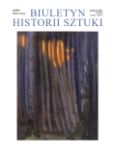„Obraz srebrny” z kościoła kanoników regularnych w Mstowie
‘'Silver Painting' from the Church of the Canons Regular in Mstów
Author(s): Paweł DettloffSubject(s): Christian Theology and Religion, Visual Arts, 17th Century, 18th Century, History of Art
Published by: Instytut Sztuki Polskiej Akademii Nauk
Keywords: Regular Canons Church in Mstów; the miraculous painting of Our Lady of Mstowska; silver dress; Częstochowa workshop;
Summary/Abstract: The silver robe covering the miraculous painting of Our Lady of Mstów in the church of the Canons Regular in Mstów (at present currently Wancerzów) near Częstochowa is discussed. The oldest written record referring to this artifact dates back to 1704, defining it as a ‘silver painting’. Actually, the silver applique design on the miraculous effigy covers almost the whole of its surface (except for the faces), while the shape of the cover resembles the representation underneath. The robe was made of silver, partially gilded embossed sheet, engraved in parts. The upper part of figural elements are almost solid realistically rendered, made as a cast. An interesting and precious piece of goldsmithery, encompassed within the tradition of adorning miraculous images with metal applications, it ranks among the robes put upon sacral pictures so numerous in the Polish-Lithuanian Commonwealth, representing, however, its less typical variety. Covering the whole of the painting showing Our Lady, it is actually bigger (48x38 cm) than the small picture itself (25x30 cm). The silver sheet, namely the application with a full-bodied presentation of the figure, has practically taken over the role of the original. in this way, it has become its visual transformation and a ‘new picture’. This is the version the faithful have seen until today. Furthermore, the dependence of the depictions on the robe on the print popularizing the miraculous effigy of Our Lady of Częstochowa is interesting. Neither the circumstances nor the exact date of the piece’s foundation are known. However, based on the above analysis, it can be assumed that the dress was executed in the last decade of the 17th century or in the early 18th century, most likely before 1704. What strikes in the work is a genuine design composition and ‘compiled’ ornamental decoration, as well as high quality of craftsmanship. Among the applied ornaments, acanthus and auricular motifs, the latter resembling schweifwerk ornament, can be found. Although stylistically retarded, the Mstów robe remains a precious work of artistic craftsmanship; an anonymous piece produced possibly by a Częstochowa workshop; it demonstrated its high technical and artistic capacity. An important set, integrally connected with the discussed artifact, can be seen in the 17th-century pieces of jewelry adorning the silver sheet of the robe.
Journal: Biuletyn Historii Sztuki
- Issue Year: 81/2019
- Issue No: 4
- Page Range: 559-581
- Page Count: 23
- Language: Polish

